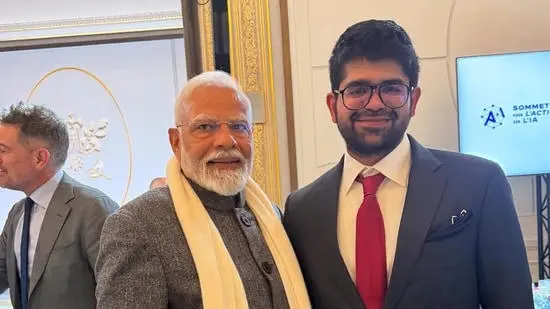
Aravind Srinivas’s ₹3.3 million crore offer to buy Google’s homepage may have been rejected
In a world where digital real estate is more valuable than ever, one man dared to dream bigger than anyone else. Aravind Srinivas, the Indian-origin CEO of Perplexity AI, stunned the tech world with a jaw-dropping offer: ₹3.3 million crore (over $400 trillion USD) to acquire exclusive rights to the Google homepage. Not the company. Not its data. Just the homepage, the most visited webpage on Earth.
While the offer was swiftly declined, its symbolism and ambition have sparked global debate. Was it a publicity stunt? A philosophical statement? Or a visionary’s attempt to redefine how we interact with the internet? Let’s unpack the story, the man behind it, and the ripple effects of this unprecedented bid.
The Man Behind the Madness: Who Is Aravind Srinivas?
Aravind Srinivas is no stranger to bold ideas. As the CEO and co-founder of Perplexity AI, a fast-rising competitor in the AI search space, he’s built a reputation for challenging the status quo. Born in India and educated at UC Berkeley and OpenAI, Srinivas blends deep technical expertise with a flair for disruption.
- Perplexity AI is known for its conversational search engine that aims to rival Google by offering direct, cited answers instead of traditional link-based results.
- Srinivas has long advocated for transparency, user empowerment, and decentralization in digital platforms.
- His leadership style is described as “relentlessly curious,” and his public statements often blur the line between tech evangelism and philosophical provocation.
So when news broke that he had offered ₹3.3 million crore to buy Google’s homepage, many saw it as a natural extension of his mission: to challenge the dominance of centralized platforms and reimagine the internet’s front door.
The Offer That Shook Silicon Valley
The bid wasn’t a tweet or a joke, it was a formal proposal, reportedly submitted through legal channels. Srinivas offered to purchase exclusive rights to the Google homepage interface, intending to transform it into a global digital canvas.
What Did the Offer Include?
- Homepage Control: Srinivas wanted to replace the minimalist search bar with rotating content—art, humanitarian messages, educational prompts, and AI-powered insights.
- No Data Access: The offer did not include access to Google’s backend, user data, or search algorithms.
- Funding Sources: The ₹3.3 million crore valuation was backed by a consortium of crypto investors, sovereign wealth funds, and speculative digital assets.
Google’s Response?
A spokesperson for Google responded tersely:
“We appreciate the creativity, but the homepage remains a public gateway to information, not a billboard.”
The rejection was expected. But the conversation it sparked was anything but ordinary.
What Does This Say About the Internet Today?
Srinivas’s offer wasn’t just about buying pixels, it was about challenging the architecture of digital power. The Google homepage is arguably the most influential piece of online real estate. It’s where billions begin their day, their research, their decisions.
Key Themes Raised by the Bid:
- Digital Ownership: Who owns the internet’s most visible spaces? Should they be open, neutral, or monetized?
- Visibility as Power: Srinivas’s bid highlights how visibility, not just data is the new currency. Controlling what people see first is a form of influence.
- Decentralization vs. Centralization: The offer aligns with a growing movement to decentralize the web, moving away from monopolistic platforms toward user-owned ecosystems.
- Philosophical Provocation: Srinivas described the homepage as “the most powerful blank canvas in human history.” His vision was to turn it into a space for global reflection, not just search.
Whether you see it as satire, strategy, or sincere ambition, the bid forces us to rethink how we interact with the digital world and who gets to shape it.
Global Reactions and Ripple Effects
The tech community responded with a mix of awe, skepticism, and admiration. While many dismissed the offer as impractical, others saw it as a symbolic strike against digital complacency.
Industry Reactions:
- Tech Entrepreneurs: Some praised Srinivas for “thinking beyond the algorithm,” calling the bid a wake-up call for innovation.
- Digital Ethicists: Experts debated the ethics of privatizing public digital spaces, warning against turning the internet into a billboard.
- Crypto Enthusiasts: The use of speculative digital assets to back the offer reignited discussions about the future of decentralized finance and digital valuation.
Public Sentiment:
- Supporters: Many admired the boldness, comparing it to Elon Musk’s Twitter acquisition—except more philosophical.
- Critics: Others called it a vanity stunt, arguing that the homepage should remain neutral and untouched.
Competitor Impact:
- Perplexity AI saw a surge in traffic and media attention, with users curious about the platform that dared to challenge Google.
- Google remained unfazed publicly, but insiders suggest the company is watching Perplexity’s rise with increasing interest.
Final Thoughts: A Bid That Wasn’t About Buying
Aravind Srinivas’s ₹3.3 million crore offer to buy Google’s homepage may have been rejected, but its impact is undeniable. It wasn’t just a bid, it was a statement. A challenge to the norms of digital design, a call for democratized visibility, and a reminder that the internet is still a space for imagination.
In an age where algorithms shape thought and platforms dictate behaviour, Srinivas dared to ask:
What if the most powerful page on the internet belonged to everyone, not just a corporation? Whether or not you agree with his methods, one thing is clear: the future of the internet will be shaped by those bold enough to question it.
Also read – Google Unveils Gemini 2.5 Pro: AI’s Next Leap in Advanced Reasoning and Deep Think Mode
2 thoughts on “The 3 Million Crore Masterstroke: Aravind Srinivas and the Audacious Bid to Own Google’s Front Door”
Comments are closed.